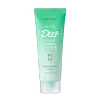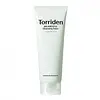What's inside
What's inside
 Key Ingredients
Key Ingredients

 Benefits
Benefits

 Concerns
Concerns

 Ingredients Side-by-side
Ingredients Side-by-side

Water
Skin ConditioningSodium C14-16 Olefin Sulfonate
CleansingLauryl Hydroxysultaine
CleansingSodium Methyl Cocoyl Taurate
CleansingGlycerin
HumectantAcrylates/C10-30 Alkyl Acrylate Crosspolymer
Emulsion StabilisingCaprylyl Glycol
EmollientCentella Asiatica Extract
CleansingSodium Chloride
Masking1,2-Hexanediol
Skin ConditioningSalicylic Acid
MaskingHexadecene
SolventTetradecene
EmollientMentha Piperita Oil
MaskingSodium Sulfate
Mentha Piperita Extract
CleansingCentella Asiatica Leaf Extract
Skin ConditioningMelia Azadirachta Leaf Extract
Skin ConditioningDisodium EDTA
Betaine
HumectantAllantoin
Skin ConditioningPanthenol
Skin ConditioningMelia Azadirachta Flower Extract
Skin ConditioningDextrin
AbsorbentTheobroma Cacao Extract
Skin ConditioningPropanediol
SolventBetula Platyphylla Japonica Juice
Skin ConditioningButylene Glycol
HumectantPapain
Skin ConditioningHydrolyzed Sodium Hyaluronate
Skin ConditioningGinkgo Biloba Leaf Extract
Skin ConditioningArtemisia Annua Extract
MaskingEthylhexylglycerin
Skin ConditioningFicus Carica Fruit Extract
HumectantAloe Barbadensis Leaf Extract
EmollientDioscorea Japonica Root Extract
Skin ConditioningLaminaria Japonica Extract
Skin ProtectingLactobacillus Ferment Lysate
Skin ConditioningViola Mandshurica Flower Extract
AntioxidantUlmus Davidiana Root Extract
Skin ConditioningPentylene Glycol
Skin ConditioningTaraxacum Officinale Leaf Extract
Skin ConditioningWater, Sodium C14-16 Olefin Sulfonate, Lauryl Hydroxysultaine, Sodium Methyl Cocoyl Taurate, Glycerin, Acrylates/C10-30 Alkyl Acrylate Crosspolymer, Caprylyl Glycol, Centella Asiatica Extract, Sodium Chloride, 1,2-Hexanediol, Salicylic Acid, Hexadecene, Tetradecene, Mentha Piperita Oil, Sodium Sulfate, Mentha Piperita Extract, Centella Asiatica Leaf Extract, Melia Azadirachta Leaf Extract, Disodium EDTA, Betaine, Allantoin, Panthenol, Melia Azadirachta Flower Extract, Dextrin, Theobroma Cacao Extract, Propanediol, Betula Platyphylla Japonica Juice, Butylene Glycol, Papain, Hydrolyzed Sodium Hyaluronate, Ginkgo Biloba Leaf Extract, Artemisia Annua Extract, Ethylhexylglycerin, Ficus Carica Fruit Extract, Aloe Barbadensis Leaf Extract, Dioscorea Japonica Root Extract, Laminaria Japonica Extract, Lactobacillus Ferment Lysate, Viola Mandshurica Flower Extract, Ulmus Davidiana Root Extract, Pentylene Glycol, Taraxacum Officinale Leaf Extract
Water
Skin ConditioningGlycerin
HumectantStearic Acid
CleansingLauric Acid
CleansingPotassium Hydroxide
BufferingPotassium Cocoyl Glycinate
Dipropylene Glycol
HumectantPotassium Cocoate
EmulsifyingGlyceryl Stearate Se
EmulsifyingLauryl Glucoside
CleansingSalicylic Acid
MaskingCentella Asiatica Extract
CleansingMadecassoside
AntioxidantAsiaticoside
AntioxidantAsiatic Acid
Skin ConditioningMadecassic Acid
Skin ConditioningPanthenol
Skin ConditioningGluconolactone
Skin ConditioningAllantoin
Skin ConditioningTocopherol
AntioxidantAlthaea Rosea Flower Extract
Skin ConditioningNymphaea Caerulea Flower Extract
Skin ConditioningLactobacillus Ferment
Skin ConditioningSwertia Japonica Extract
Skin ConditioningPentylene Glycol
Skin ConditioningButylene Glycol
HumectantSodium Cocoyl Isethionate
CleansingSodium Isethionate
CleansingCaprylyl Glycol
EmollientDisodium EDTA
Dextrin
AbsorbentSodium Benzoate
MaskingCoconut Acid
CleansingEthylhexylglycerin
Skin ConditioningPolyquaternium-7
1,2-Hexanediol
Skin ConditioningRosmarinus Officinalis Leaf Oil
MaskingDecyl Glucoside
CleansingGardenia Florida Fruit Extract
Skin ConditioningCarthamus Tinctorius Flower Extract
Skin ConditioningWater, Glycerin, Stearic Acid, Lauric Acid, Potassium Hydroxide, Potassium Cocoyl Glycinate, Dipropylene Glycol, Potassium Cocoate, Glyceryl Stearate Se, Lauryl Glucoside, Salicylic Acid, Centella Asiatica Extract, Madecassoside, Asiaticoside, Asiatic Acid, Madecassic Acid, Panthenol, Gluconolactone, Allantoin, Tocopherol, Althaea Rosea Flower Extract, Nymphaea Caerulea Flower Extract, Lactobacillus Ferment, Swertia Japonica Extract, Pentylene Glycol, Butylene Glycol, Sodium Cocoyl Isethionate, Sodium Isethionate, Caprylyl Glycol, Disodium EDTA, Dextrin, Sodium Benzoate, Coconut Acid, Ethylhexylglycerin, Polyquaternium-7, 1,2-Hexanediol, Rosmarinus Officinalis Leaf Oil, Decyl Glucoside, Gardenia Florida Fruit Extract, Carthamus Tinctorius Flower Extract
 Reviews
Reviews

Ingredients Explained
These ingredients are found in both products.
Ingredients higher up in an ingredient list are typically present in a larger amount.
1,2-Hexanediol is a synthetic liquid and another multi-functional powerhouse.
It is a:
- Humectant, drawing moisture into the skin
- Emollient, helping to soften skin
- Solvent, dispersing and stabilizing formulas
- Preservative booster, enhancing the antimicrobial activity of other preservatives
Allantoin is a soothing ingredient known for its protective and moisturizingg properties. Because of this, it is often added to products with strong active ingredients.
Studies show higher concentrations of this ingredient can promote wound healing.
Though it can be derived from the comfrey plant, allantoin is produced synthetically for cosmetic products to ensure purity.
Learn more about AllantoinButylene Glycol (or BG) is used within cosmetic products for a few different reasons:
Overall, Butylene Glycol is a safe and well-rounded ingredient that works well with other ingredients.
Though this ingredient works well with most skin types, some people with sensitive skin may experience a reaction such as allergic rashes, closed comedones, or itchiness.
Learn more about Butylene GlycolCaprylyl Glycol is a humectant and emollient, meaning it attracts and preserves moisture.
It is a common ingredient in many products, especially those designed to hydrate skin. The primary benefits are retaining moisture, skin softening, and promoting a healthy skin barrier.
Though Caprylyl Glycol is an alcohol derived from fatty acids, it is not the kind that can dry out skin.
This ingredient is also used as a preservative to extend the life of products. It has slight antimicrobial properties.
Learn more about Caprylyl GlycolCentella Asiatica Extract (Centella) is derived from an herb native to Southeast Asia. It is famous for its anti-inflammatory and soothing properties.
Centella is rich in antioxidants and amino acids, such as Madecassic Acid and Asiaticoside.
Studies show the compounds in centella help with:
The combination of all these properties makes centella effective at soothing, hydrating, and protecting the skin.
Other great components of centella include Vitamin A, vitamin C, several B vitamins, and Asiatic Acid.
Fun fact: Centella has been used as a medicine and in food for many centuries. As a medicine, it is used to treat burns, scratches, and wounds.
Learn more about Centella Asiatica ExtractDextrin is used to thicken a product and helps bind ingredients together. It is created from starch and glycogen.
As an emulsifier, dextrin prevents ingredients from separating. This helps elongate a product's shelf life.
Studies show coating UV filters with dextrin prevents these ingredients from being absorbed. This helps UV ingredients last longer on the skin.
Learn more about DextrinDisodium EDTA plays a role in making products more stable by aiding other preservatives.
It is a chelating agent, meaning it neutralizes metal ions that may be found in a product.
Disodium EDTA is a salt of edetic acid and is found to be safe in cosmetic ingredients.
Learn more about Disodium EDTAEthylhexylglycerin (we can't pronounce this either) is commonly used as a preservative and skin softener. It is derived from glyceryl.
You might see Ethylhexylglycerin often paired with other preservatives such as phenoxyethanol. Ethylhexylglycerin has been found to increase the effectiveness of these other preservatives.
Glycerin is already naturally found in your skin. It helps moisturize and protect your skin.
A study from 2016 found glycerin to be more effective as a humectant than AHAs and hyaluronic acid.
As a humectant, it helps the skin stay hydrated by pulling moisture to your skin. The low molecular weight of glycerin allows it to pull moisture into the deeper layers of your skin.
Hydrated skin improves your skin barrier; Your skin barrier helps protect against irritants and bacteria.
Glycerin has also been found to have antimicrobial and antiviral properties. Due to these properties, glycerin is often used in wound and burn treatments.
In cosmetics, glycerin is usually derived from plants such as soybean or palm. However, it can also be sourced from animals, such as tallow or animal fat.
This ingredient is organic, colorless, odorless, and non-toxic.
Glycerin is the name for this ingredient in American English. British English uses Glycerol/Glycerine.
Learn more about GlycerinPanthenol is a common ingredient that helps hydrate and soothe the skin. It is found naturally in our skin and hair.
There are two forms of panthenol: D and L.
D-panthenol is also known as dexpanthenol. Most cosmetics use dexpanthenol or a mixture of D and L-panthenol.
Panthenol is famous due to its ability to go deeper into the skin's layers. Using this ingredient has numerous pros (and no cons):
Like hyaluronic acid, panthenol is a humectant. Humectants are able to bind and hold large amounts of water to keep skin hydrated.
This ingredient works well for wound healing. It works by increasing tissue in the wound and helps close open wounds.
Once oxidized, panthenol converts to pantothenic acid. Panthothenic acid is found in all living cells.
This ingredient is also referred to as pro-vitamin B5.
Learn more about PanthenolPentylene glycol is typically used within a product to thicken it. It also adds a smooth, soft, and moisturizing feel to the product. It is naturally found in plants such as sugar beets.
The hydrophilic trait of Pentylene Glycol makes it a humectant. As a humectant, Pentylene Glycol helps draw moisture from the air to your skin. This can help keep your skin hydrated.
This property also makes Pentylene Glycol a great texture enhancer. It can also help thicken or stabilize a product.
Pentylene Glycol also acts as a mild preservative and helps to keep a product microbe-free.
Some people may experience mild eye and skin irritation from Pentylene Glycol. We always recommend speaking with a professional about using this ingredient in your routine.
Pentylene Glycol has a low molecular weight and is part of the 1,2-glycol family.
Learn more about Pentylene GlycolSalicylic Acid (also known as beta hydroxy acid or BHA) is a well-known ingredient for treating skin that struggles with acne and clogged pores. It exfoliates both the skin's surface and deep within the pores to help clear out buildup, control oil, and reduce inflammation.
Unlike AHAs (alpha hydroxy acids), salicylic acid is oil-soluble. This allows it to penetrate into pores which makes it especially effective for treating blackheads and preventing future breakouts.
Salicylic acid is also known for its soothing properties. It has a similar structure to aspirin and can calm inflamed or irritated skin, making it a good option for acne-prone skin that is also sensitive.
Concentrations of 0.5-2% are recognized by the U.S. FDA as an over-the-counter topical acne product.
It can cause irritation and/or dryness if one's skin already has a compromised moisture barrier, so it's best to focus on repairing that before introducing this ingredient into your routine.
While salicylic acid does not increase sun sensitivity, it’s still important to wear sunscreen daily to protect your skin.
If you are looking for the ingredient called BHA or Butylated Hydroxyanisole, click here.
Learn more about Salicylic AcidWater. It's the most common cosmetic ingredient of all. You'll usually see it at the top of ingredient lists, meaning that it makes up the largest part of the product.
So why is it so popular? Water most often acts as a solvent - this means that it helps dissolve other ingredients into the formulation.
You'll also recognize water as that liquid we all need to stay alive. If you see this, drink a glass of water. Stay hydrated!
Learn more about Water